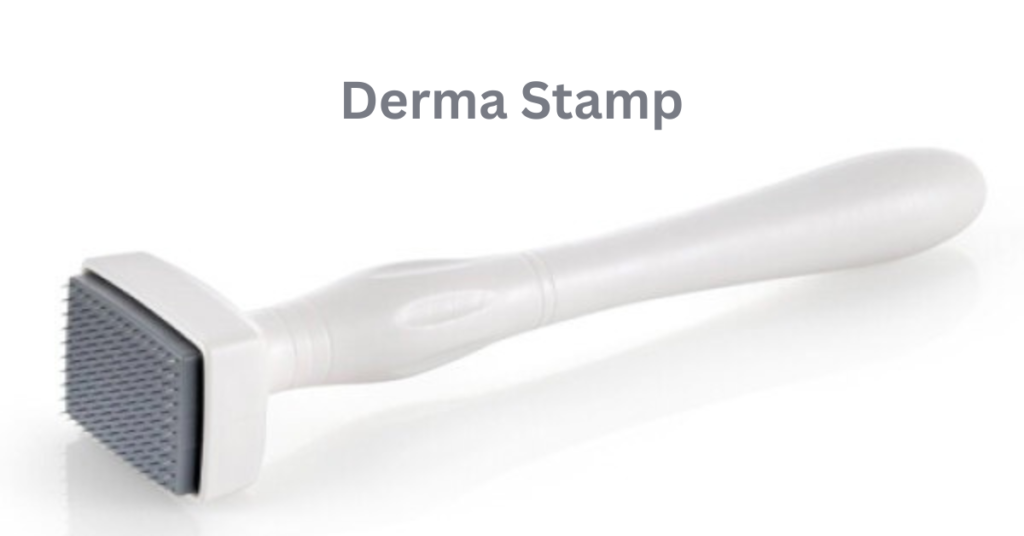Are you seeking smoother, healthier skin without invasive treatments or lengthy recovery times? The Derma Stamp, a cutting-edge tool in skincare, offers a powerful solution for those looking to enhance their skin’s texture, tone, and overall appearance. Unlike traditional microneedling tools, the derma stamp offers precise, targeted treatment, making it a popular choice for tackling scars, wrinkles, and enlarged pores.
This comprehensive guide will walk you through what the derma stamp is, how it works, its benefits, and how to use it safely for the best results. With this information, you’ll have everything you need to embark on your journey toward radiant skin.
What is a Derma Stamp?
The Derma Stamp is a specialized skincare tool designed for microneedling, which involves creating tiny, controlled punctures in the skin. These micro-injuries stimulate the skin’s natural healing process, promoting the production of collagen and elastin, essential proteins that keep the skin firm and youthful.
Unlike a derma roller, which rolls across the skin creating micro-injuries in a broader area, the derma stamp allows for precise targeting of specific areas. This makes it ideal for treating concentrated skin issues, such as acne scars, fine lines, or hyperpigmentation. The stamp’s needle length can vary, allowing you to adjust treatment based on the severity of the skin concern.
How Does the Derma Stamp Work?
The derma stamp functions through controlled wounding. When the tiny needles penetrate the skin, they signal to the body that an injury has occurred, prompting the natural healing process. This process is called collagen induction therapy (CIT), which helps in boosting collagen production to repair the skin.
The key mechanism involves:
- Micro-needling: The needles create tiny holes or “micro-channels” in the skin.
- Healing Response: These micro-injuries stimulate skin cells to produce more collagen and elastin.
- Skin Renewal: Over time, the skin repairs itself, resulting in a smoother, more youthful appearance.
Benefits of Using a Derma Stamp
The derma stamp offers a multitude of skin benefits, making it a favorite among skincare enthusiasts. Here’s why you might want to include it in your skincare routine:
1. Reduced Acne Scars
One of the most popular uses of the derma stamp is for acne scar treatment. The controlled micro-injuries encourage skin cell turnover and new collagen production, which helps in smoothing out the depressions left by acne scars.
2. Diminished Fine Lines and Wrinkles
As we age, collagen production slows down, leading to the formation of fine lines and wrinkles. By using the derma stamp, you can boost collagen levels, helping to plump the skin and smooth out wrinkles, giving the skin a more youthful appearance.
3. Improved Skin Texture
If you’re dealing with uneven skin texture or enlarged pores, the derma stamp can help to refine skin tone. By promoting collagen production and cellular turnover, the skin appears smoother and more even over time.
4. Enhanced Absorption of Skincare Products
The microchannels created by the derma stamp allow for better absorption of serums and treatments, such as hyaluronic acid, vitamin C, or other nourishing ingredients. This means that your products penetrate deeper into the skin, making them more effective.
5. Minimized Hyperpigmentation
For those with sun spots, melasma, or post-inflammatory hyperpigmentation, the derma stamp can be an effective tool in reducing discoloration. By promoting healthy skin turnover, the pigmentation fades, leaving behind a clearer complexion.
6. Safe for Delicate Areas
Unlike some other skincare tools, the derma stamp is safe to use around more delicate areas such as under the eyes, where wrinkles tend to form more quickly.
How to Use the Derma Stamp Safely
Before you begin your derma stamp journey, it’s crucial to understand how to use the tool correctly to avoid any adverse effects. Here’s a step-by-step guide to using the stamp safely and effectively.
1. Cleanse Your Skin
Start with a clean face. Use a gentle, non-abrasive cleanser to remove dirt, oil, and makeup from your skin. This ensures that the stamp will not push any impurities deeper into your skin.
2. Disinfect the Derma Stamp
Before using the derma stamp, make sure to disinfect it with alcohol. This step is crucial to prevent any infections or bacterial contamination during the treatment.
3. Prepare Your Skin
Apply a numbing cream if you have sensitive skin or are using a needle length of 0.5 mm or longer. Let it sit for about 15-20 minutes before wiping it off.
4. Stamp the Skin
Start by pressing the derma stamp gently onto your skin. Focus on areas that need treatment, such as scars, wrinkles, or pigmentation. Do not drag the stamp across your skin; simply press and lift. This ensures precise micro-injuries.
5. Apply a Hydrating Serum
Immediately after treatment, apply a hydrating serum like hyaluronic acid or a skin-repairing product. Your skin is in a prime state to absorb nutrients, so this step maximizes the benefits.
6. Avoid Sun Exposure
Your skin will be more sensitive to sunlight after treatment, so avoid direct sun exposure for at least 24-48 hours. If you must go outside, wear a high-SPF sunscreen to protect your skin.
7. Be Consistent but Patient
Consistency is key when using the derma stamp. You should aim for treatments every 2-4 weeks, depending on your skin’s tolerance. However, patience is crucial, as visible improvements may take a few weeks or months.
Choosing the Right Needle Length
The derma stamp comes with different needle lengths, each suitable for addressing specific skin concerns. Understanding which length to choose is crucial for effective results.
- 0.25 mm – 0.5 mm: Ideal for improving product absorption and stimulating collagen for slight skin texture issues or fine lines.
- 0.75 mm – 1.0 mm: Great for treating deeper skin concerns such as mild to moderate acne scars, pigmentation, and deeper wrinkles.
- 1.5 mm – 2.0 mm: Used for more severe scarring, stretch marks, or deeper wrinkles. These lengths are generally recommended for professional use.
Always start with the shorter needle lengths if you’re new to derma stamping, and gradually move up as your skin becomes accustomed to the treatment.
Derma Stamp vs. Derma Roller: Which One is Right for You?
When comparing the derma stamp and the derma roller, it’s important to note that both tools offer microneedling benefits, but they differ in their approach.
1. Precision vs. Coverage
The derma stamp is excellent for precise areas, such as acne scars or fine lines, whereas the derma roller is better suited for covering larger areas of the skin.
2. Risk of Skin Tearing
Since the derma stamp is pressed into the skin rather than rolled, there is a lower risk of skin tearing. This makes the stamp a safer option, especially for sensitive skin or delicate areas.
3. Recovery Time
Both tools can cause temporary redness and irritation, but the derma stamp’s precise application means recovery time is often shorter compared to the broader coverage of the roller.
Post-Treatment Care: What to Do After Derma Stamping
Proper aftercare is critical to maximize the benefits of derma stamping and avoid complications. Here’s how to care for your skin post-treatment:
1. Hydrate, Hydrate, Hydrate
Your skin will be thirsty for moisture after the treatment. Use a hydrating serum or moisturizer to soothe the skin and promote healing.
2. Avoid Active Ingredients
Stay away from skincare products that contain active ingredients like retinol, AHAs, or BHAs for at least 48 hours. These can further irritate the skin and slow down the healing process.
3. Don’t Touch Your Face
It might be tempting, but avoid touching your face after derma stamping to reduce the risk of infection. Also, make sure your pillowcases and towels are clean.
4. Skip the Makeup
Give your skin a break from makeup for 24-48 hours to allow for optimal healing. If you must wear makeup, opt for non-comedogenic, lightweight formulas.
Common Mistakes to Avoid When Using a Derma Stamp
Even though the derma stamp is a powerful tool, using it incorrectly can lead to unwanted side effects. Here are some common mistakes to avoid:
- Overuse: Don’t use the stamp too often. Overuse can damage your skin’s barrier and cause irritation.
- Skipping the Disinfection: Always disinfect the derma stamp before and after use. Neglecting this step can introduce bacteria into your skin.
- Using on Active Acne: Never use a stamp on active breakouts, as it can spread bacteria and worsen the condition.
- Pressing Too Hard: Be gentle with your skin. Pressing the stamp too hard can cause unnecessary injury and prolong healing time.
Final Thoughts
The derma stamp is a versatile, effective tool that can deliver remarkable results when used properly. Whether you’re targeting acne scars, wrinkles, or hyperpigmentation, it offers a non-invasive way to rejuvenate your skin. With consistent use, patience, and proper aftercare, you can achieve a healthier, smoother, and more radiant complexion.







